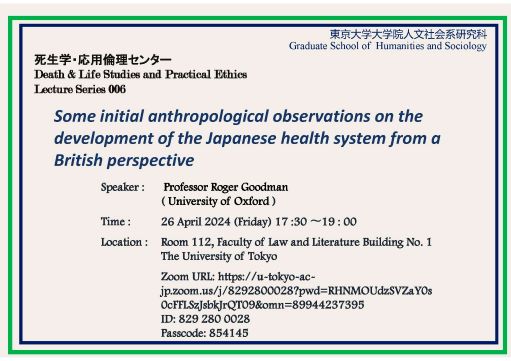Some initial anthropological observations on the development of the Japanese health system from a British perspective

【日時】2024年4月26日(金) 17:30-19:00
【会場】 東京大学本郷キャンパス 文学部法文1号112教室
【オンライン会場】Zoom ID: 829 280 0028 (Passcode: 854145)
https://u-tokyo-ac-jp.zoom.us/j/8292800028?pwd=RHNMOUdzSVZaY0s0cFFLSzJsbkJrQT09&omn=89944237395(学内限り)
【参加について】参加無料・事前予約不要
【使用言語】英語(通訳なし)
【主催】東京大学大学院人文社会系研究科 死生学・応用倫理センター
【共催】東京大学 国際人文学プロジェクト
講師紹介 Speaker: Roger Goodman (Professor, Nissan Institute of Japanese Studies, University of Oxford)
This talk is based on six months’ of fieldwork looking at the Japanese health system through an anthropological lens. It builds on earlier research which looked at the Japanese welfare and education system and in particular the role of family business. Children of the Japanese State: The Changing Role of Child Protection Institutions in Contemporary Japan, Oxford University Press. Published in Japanese as: 日本の児童養護:児童養護学への招待, 明石書店. Family-run Universities in Japan: Sources of Inbuilt Resilience in the face of Demographic Pressure, 1992-2030, Oxford University Press. Published in Japanese as: 日本の私立大学はなぜ生き残るのか: 人口減少社会と同族経営:1992-2030, 中央公論.
In terms of its health institutions, the 1948 Medical Service Act allowed physicians to own medical facilities as sole proprietors, and amendments in 1950 allowed family run medical corporations dōzoku keiei iryō hōjin to own medical facilities; revisions to the Medical Service Act in the 1980s gave these institutions greater control over their management. According to a leading expert on Japanese health policy, Ikegami Naoki, as a result of this legislation, by the mid-1980s, around 80% of all hospitals and around 90% of clinics were private and, of these private institutions in total, up to 75% were family-run. Given the size and apparent success of the health system in Japan, and the proportion of family-run medical institutions within it, the almost complete absence of research and writing on such institutions (either in English or Japanese) is conspicuous.
This research sets out to see if there is a connection between some of the most marked characteristics of the Japanese health system and the high proportion of family-run clinics and hospitals. These characteristics include: the high number of hospital beds; the long stays in hospitals; the large number of visits to doctor and use of tests such as MRIs and CTs. In particular, it will look at the highly fragmented nature of the system (which was highlighted during the COVID pandemic) and contrast it with the highly centralised and efficient view of Japan as set out, for example, in Chalmers Johnson’s account of the developmental state.